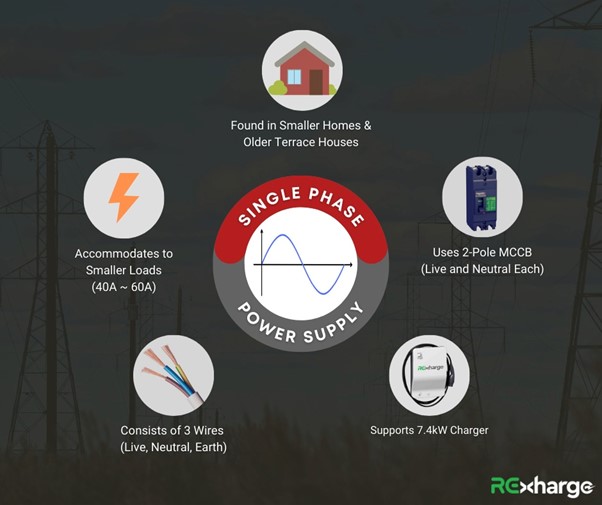Installing Home EV Charger in Malaysia: Understanding Your House’s Electrical Power Supply
Electric Vehicles (EVs) are becoming increasingly popular in Malaysia, and as more people make the switch from conventional vehicles to EVs, the demand for reliable and efficient charging solutions grows. The first crucial aspect to consider when installing an EV charger at home is your house’s electrical power supply. This article delves into the differences between single-phase and three-phase power supplies, their compatibility with EV chargers, and the process of upgrading your electrical system in Malaysia.
Single Phase vs Three Phase


Single Phase Power Supply

Single-phase power supply is commonly found in smaller homes and older terrace houses across Malaysia. Here are some key characteristics of a single-phase power supply:
- Components: Uses a 2-pole MCCB (Miniature Circuit Breaker) with live and neutral poles.
- Charger Compatibility: Supports up to 7.4kW chargers, which effectively means it can only handle 7kW chargers.
- Wiring: Consists of three wires – live, neutral, and earth.
- Load Capacity: Typically accommodates smaller electrical loads ranging from 40A to 60A.
Three Phase Power Supply

On the other hand, three-phase power supply is more prevalent in larger houses or homes that have been upgraded to accommodate higher electrical demands. Here’s what you need to know about a three-phase power supply:
- Components: Uses a 3-pole MCCB, incorporating three live poles, one neutral pole, and one earth pole.
- Charger Compatibility: Supports higher-powered chargers, including 11kW and 22kW options.
- Wiring: Consists of five wires – three live wires (phases), one neutral, and one earth.
- Load Capacity: Can handle larger electrical loads ranging from 60A to 100A.
Benefits of Upgrading to Three Phase Power Supply
Handling Higher Loads
One of the primary reasons to upgrade to a three-phase power supply is to accommodate higher electrical loads, especially for larger homes with multiple appliances and devices.
Increased Stability and Reliability
Three-phase power systems offer enhanced stability and reliability compared to single-phase systems, ensuring a consistent and uninterrupted power supply for your EV charger.
Future-Proofing for EV Charger Installations
Opting for a three-phase power supply is a smart way to future-proof your home for upcoming EV charger installations in Malaysia, which are likely to require higher-powered charging solutions.
Important info on upgrading to Three Phase power Supply
If you’re considering upgrading your electrical system to a three-phase power supply, here’s what you need to know about the application process:
Apply at Tenaga Nasional Berhad
You can submit your application either online directly on TNB or through a verified contractor like RExharge.
Cost
The cost of upgrading typically ranges from RM2,000 to RM10,000, depending on the complexity of the installation and the specific requirements of your home.
Duration
The upgrading process usually takes a few days to a week to complete, during which you may experience temporary disruptions to your power supply.
Hiring Qualified Electricians
Lastly, it’s crucial to hire experienced and qualified electricians to conduct the upgrading works safely and efficiently. This will ensure that the installation meets all safety standards and regulations, minimising the risk of electrical faults or hazards.
Conclusion
In conclusion, understanding your house’s electrical power supply is essential for selecting the right EV charger and ensuring a smooth and efficient charging experience. Whether you opt for a single-phase or three-phase power supply, make sure to consider your current and future electrical needs, and consult with professionals to make informed decisions. As the EV market continues to grow in Malaysia, having a reliable and robust electrical infrastructure will become increasingly important for EV owners.


